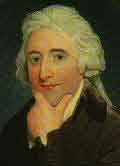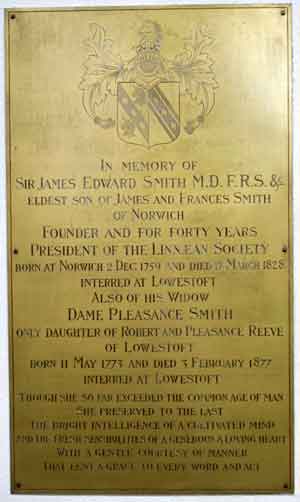James Edward Smith (1759-1828).

James Edward Smith was born in 1759 in Norwich, the eldest son of James Smith, a wealthy wool merchant, and showed an early interest in flowers. His study of botany as a science began when he was eighteen and then, it is said, on the very day of Linnaeus’ death. As it was possible at that time to attend lectures on botany only as part of a medical course, in 1781 Smith went to study medicine at Edinburgh University. Here he met Dr. Hope, Professor of Botany, and the first to teach the Linnaean system in Scotland. At the age of 22, Smith and a few friends decided to form a natural history society in Edinburgh through which they established a collection of Scottish native plants. Dr. Hope was made an honorary member.
In 1783, Smith returned to London to continue his medical studies under John Hunter and William Pitcairn.
Following the death of Linnaeus in 1778 and then, five years later, Linnaeus’ son, Carl (who had inherited his father’s collection), Sir Joseph Banks, an acquaintance of Smith, was offered the whole collection for 1,000 guineas. Banks declined the offer, but urged Smith to make the purchase himself. Smith agreed, and the collection of nearly 3,000 books, plants, minerals, insects and manuscripts arrived in London in October, 1784. Smith hired rooms in Chelsea to display the collection. On the strength of the surrounding publicity, he was made a Fellow of the Royal Society.
In 1785, Smith, the Rev Dr Samuel Goodenough and Thomas Marsham agreed to form a new society dedicated to natural history. However, Smith, now aged 27, decided to take the grand tour of Europe and in 1786, financially supported by his father, he visited France and Italy as well as taking time to complete his medical doctorate in Leyden.
In February 1788, Smith returned to the coffee houses of London which formed the backdrop to the intensifying debate and discussion in the natural sciences. His interests increasingly moved away from his medical studies to focus more and more on natural history.
On Tuesday, 26th February 1788, the seeds of the natural history society that exists to this day were sown in the Marlborough Coffee House, London. The Society’s first meeting took place on 8th April 1788 at Smith’s home when the name The Linnean Society of London was taken, with Smith appointed as the first President - a position he held until the end of his life.
In 1790, Smith started on his first major work, English Botany, which brought him the acquaintance of leading botanists. In 1793, Smith published his book Sketch of a Tour on the Continent, describing his travels in Europe. As well as lecturing widely, he instructed Queen Charlotte and the Princesses in botany and zoology. In 1796, Smith married Pleasance Reeve, and subsequently moved to Norwich.
During 1784-1787 John Sibthorp, the Oxford Professor of Botany, was travelling and collecting plants in Greece and Asia Minor. On his return to England, he started working on the folio Flora Graeca (1806-1840), but died soon afterward. Smith was appointed as the "competent botanist" to prepare the work for publication. By the time of his death, Smith had completed seven and a half volumes of the work which included beautiful plates by Ferdinand Bauer.
At the turn of the 19th century, Smith published the first two volumes of Flora Britannica. This comprehensive flora of Britain was far superior to previous British floras, and even today remains valuable for its identification of plants mentioned in pre-Linnaean botanical literature. In 1808, Smith agreed to write for Abraham Rees, the editor of the Cyclopaedia or Universal Dictionary, eventually contributing 3,348 items on botany as well as brief biographies of 57 botanists.
Smith’s health, never good, began to decline seriously during the last five years of his life. However, he was still writing, and his last book was The English Flora (4 vols., 1824-1828) a much expanded version of his earlier Flora Britannica. Smith died in 1828 \nd was buried in St Peter Mancroft church. He left all his own collections, Linnaeus’ collections, and his books and prints, to his executor, William Drake, to be sold all together in one lot to a public or corporate body. These collections were eventually purchased by the Society for £3,150, a vast sum in 1828, and one which incurred a heavy debt which was not completely paid off until 1861.
Text & portrait courtesy of the Linnean Society http://linnean.org/

The Monument
A simple brass plate commemorates Sir James and his wife Dame Pleasance (1773 - 1877)

